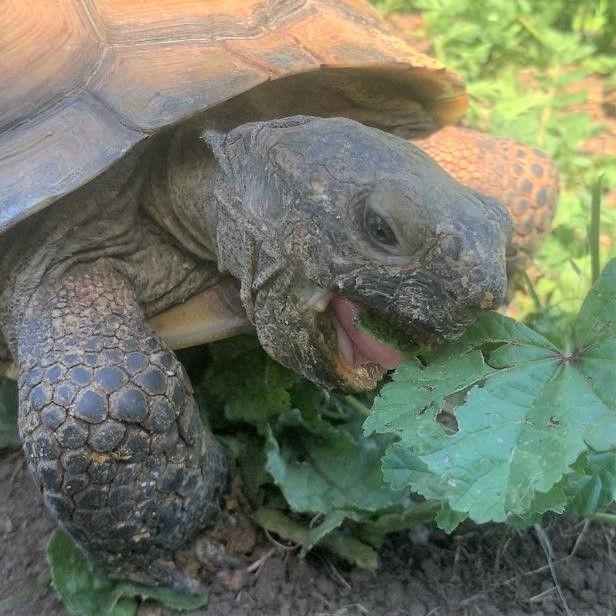Profile | Sherman and Shellby

-
BirthdayShelby, male and Shellby, female, born circa 1990–1995
-
SpeciesCalifornia desert tortoise
Gopherus agassizii -
Professor ofDesert biomes and underground corridors
-
Field of StudySlow, steady seed dispersal
-
Food and Vet Care$94 per month | $1128 per year for each tortoise
About the species
RANGE | The desert tortoise (Gopherus agassizii), is a species of tortoise native to the Mojave and Sonoran Deserts of the southwestern United States- including southeastern California, southern Nevada, western Arizona and southwestern Utah- as well as the deserts and scrubland of northwestern Mexico. The desert tortoise can live in a variety of habitats from sandy flats to rocky foothills, including alluvial fans, washes and canyons where suitable soils for den construction might be found. It is found from near sea level but up as high as roughly 3,500 feet in elevation.
In California, specifically, the desert tortoise is most often found in the desert and open washes in creosote-bush flats but also occurs in tropical deciduous forest and some grassland habitats.The eastern Sonoran Desert populations, along the Arizona border, are also often found in rocky canyons and hillsides.
FUN FACTS | The desert tortoise is the state reptile of California and Nevada. The desert tortoise is an herbivorous reptile that may attain a length of 9 to 15 inches in upper shell (carapace) length. The tortoise is able to live where ground temperatures may exceed 140 degrees F because of its ability to dig underground burrows and to escape the heat. These reptiles are one of the most elusive inhabitants of the desert, spending more than 90% of its life in underground burrows. There, it is also protected from freezing while dormant, November through February or March.
Scientists have currently divided them into two subspecies and both can occupy the same regions. The Sonoran desert tortoise is flat and pear-shaped compared to the Western Mojave tortoise which is more of a rounded dome shape. The presence of soil suitable for digging burrows is a limiting factor to desert tortoise distribution and each tortoise often has multiple burrows. Some of them are quite shallow, extending just a few feet beyond the shell of the tortoise below the surface. Others extend more than 6 feet deep and can stretch for . A single tortoise may have a dozen or more burrows distributed over its home range. These burrows may be used by different tortoises at different times.
Meet Sherman and Shellby
Sherman and Shellby came to WIldmind in July of 2020 from a Turtle and Tortoise Rehab and Rescue facility in CA. Sherman had been taken from the wild by a family who thought it would be exciting to have a living souvenir from their vacation to southern California so they took him out of his natural habitat and away from his family. When the people got to their home, they figured that he had never lived in a house so they decided he would be fine if they put him in their backyard. The different plant life and climate led to him becoming very sick so he was eventually taken to this rescue center. After a lengthy time of treatment, he recovered but cannot be released back into the desert. After a few years at this facility, Shellby arrived. She had also been illegally taken from the wild to be a pet. Without being kept at the proper temperature and not being provided a healthy diet, her immune system became compromised and she also developed significant respiratory issues. These two became great friends, always hanging out together. The person who ran the reptile rescue facility was moving to Florida. These animals cannot be moved across state lines so she needed to find a home and was determined for them to stay together. She reached out to us and we are happy to have two of our state reptiles at WIldmind.
Likes
These two love any item they can burrow into or under. We provide various plastic storage tubs, cutting holes in the side so they can move in and through them, creating a series of tunnels and pathways. Sherman and Shellby often manage to get cabinet doors open by repeatedly pushing against them and then climb inside, mimicking the natural behavior of burrowing. Like most reptiles, they also appreciate texture. They love to rub their shells against brooms and scrub brushes that we hang above them.
Wishlist
-
Tactile itemslarge scrub brushes, push brooms, or grooming massagers
-
Plastic tubsfor crawling in and through
-
Travel carrierto leave in enclosure for evac training